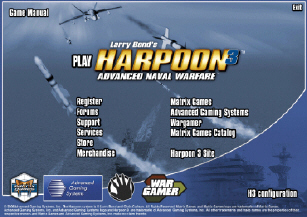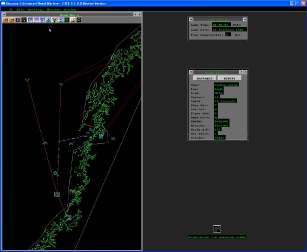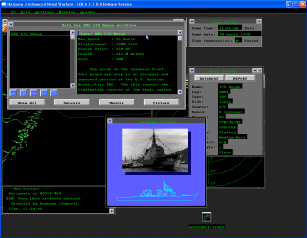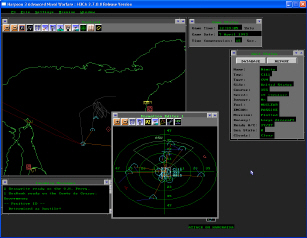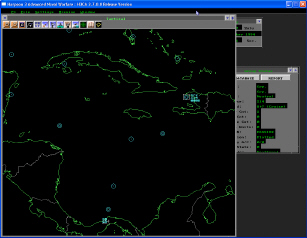|
|
||||||||
THAT CLASSIC, AGAIN MODERN NAVAL WARFARE WITH LARRY BOND'S HARPOON - COMMANDER'S EDITION
In the computer gaming world, "classics" do not last very long, holding the public interest for a matter of months, maybe a couple of years. This is not boardgaming, where the best seems to last forever. There are exceptions, and in the historical realm they are well-known: The Operational Art of War (TalonSoft/Matrix Games) comes to mind, as does the Steel Panthers series. Another, the most durable of them all, in Harpoon. Starting life as a miniatures rules set, paper Harpoon is still published by Clash of Arms Games. It was ported to the computer as a real-time modern naval simulation almost twenty years ago, an eternity by computer gaming standards. That version, originally released by Three-Sixty Pacific, became known as "Harpoon Classic", and when it was retooled for Windows by the middle of the nineties, it became the definitive version of Harpoon, the one that most players think of when they hear the name. It reached its apex in the Harpoon 97 edition, published by Interactive Magic in 1996. Harpoon 97 inherited all the strengths of the previous DOS and Windows versions, including an extensive scenario library in twelve battlesets. The maps are still the most colorful in the Harpoon line to date. If Harpoon Classic for Windows in general is the definitive form of the game to most people, then Harpoon 97 is its highest achievement. Yet even before Harpoon Classic left the confines of DOS, Three-Sixty Pacific was hard at work at a more sophisticated, and realistic game, with more simulation value. It was to have a different interface with multiple informational windows, through which the user could have more control over the information before him. Dubbed Harpoon 2, its commercial and critical success was but a shadow of Harpoon Classic's. It became something of an evolutionary dead end, at least as far as the commercial gaming market went. Over the years, computer game companies came and went. Unfortunately they mainly went, especially if they were critical to gamers who prized realism over reflexes: SSI, TalonSoft, and the publishers of Harpoon, Three-Sixty Pacific and Interactive Magic. Wargamers though still wanted their Harpoon, in a new version, and news that a new company had acquired the rights was enough to hearten them, then disappoint as soon as the company dropped the project or died outright. That disappointment is over now. Matrix Games picked up Harpoon, and stayed in business. In 2006, the new game, titled Harpoon 3: Advanced Naval Warfare, was released. At long last, naval gamers had a Harpoon for the new century. But it was not
the Harpoon that some might have expected. THE OTHER GAME
Harpoon 3 is not part of the Harpoon Classic family. It is not a direct descendent of Harpoon 97, given the characteristic Matrix Games overhaul. Instead, it is an upgrade of Harpoon 2. Some players will find that a disappointment, no doubt. After all Harpoon Classic is the accepted standard, so familiar that many player might not even know that any other version exists. For some it will prove an enlightening experience, an immersion into the other Harpoon. For most of those whose experience is confined to various iterations of Harpoon Classic, it will present an unusually steep learning curve; it is not the kind of game that one can install, look at, and immediately play. For the average Harpoon veteran whose habits are ingrained from the "Classic" side of the family, this game might be even harder than for newcomer with no habits at all. The concepts are similar, however the execution is frequently much different. Harpoon Classic has a relatively static interface, in which all the windows generally present the same kind of information in every game and act the same. Harpoon 2, and now Harpoon 3, look and feel more complicated, especially early in one's experience. There are a lot more windows, in a game a player might use three types of map, scenario, zoom and tactical, besides the formation editor. In Harpoon Classic, there is just one map, albeit a zoomable one. On the other hand, the Harpoon 3 interface is much more flexible, and can be tailored to the player's needs and wishes. The gamer can choose the colors for the display and the icons for the units, that is elementary and a trait shared with many computer games. The same goes for sounds and the videos, which in this game are films, not computer animations, as in the Harpoon Classic series. The main difference is that the player can choose which informational windows to show, how big they will be, and their stacking order. It is a lot more like a Windows business or development application than a Windows game, and as a gamer gains experience, this power over the display becomes an important tool. Reflecting the high simulation value of the Harpoon series as a whole, information is power, and in Harpoon 3 the player has a superior ability to manage how he sees that information. Yet from a technical standpoint, it does not resemble Windows software so much as a DOS program played on an emulator. Since the dawn of Windows 95, computer users (and not just gamers) have used the right mouse button as a vital element in conjuring onscreen menus, and viewing object properties. By now, it is second nature to nearly everyone. Harpoon 3 makes the right button completely useless. It might as well not even be on the mouse. The same goes for the wheel. Players cannot use it to scroll through menus, or over the map. The left mouse button and the keyboard control everything, as two out three of the controls on the mouse are rendered inoperative after over a decade of progress. All doubt about the DOS character of Harpoon 3 really should start dissipating when the game starts. The main window cannot be resized in the normal manner, and on many computers it will begin disconcertingly small. To make the game more viewable, one has to go into the Video and Sound options of the setup menu, and pick a higher screen resolution. Regardless of the size of the play area or the resolution, the graphics in this game are never awe-inspiring. The theme of the map is one of ones on a monochromatic background, with units represented by small, simple, static symbols. Even the videos are small and grainy. In the final analysis, almost everything is more bland even than the ten-year-old Harpoon 97. There is no attempt to stun the player with pretty pictures or animations. Yet this is not as bad as it might sound at first. The graphics give the player what he needs to play, and fully functional. Also, it is realistic; authentic shipboard combat information centers [CIC's] are no more colorful. Thus if the player is more interested in simulating the role of a naval officer than an arcade denizen, then the retro graphics actually enhance realism. In some ways, Harpoon 3 can be quite advanced in its interface. The flexibility of the informational windows is not a matter of style, but of crucial substance. In other ways, starting up Harpoon 3 is like entering a time warp to the early 1990's. EXPANDED SEASOne of the criticisms of Harpoon Classic is that the battlesets cover a few areas. These are hotspots, and important seas, but they are relatively few in number: The Greenland-Iceland-United Kingdom ["GIUK"] Gap and Norwegian Sea, the North Atlantic and Indian Oceans (including the Persian Gulf) and the Mediterranean Sea. There are a multitude of battles possible there, and not all of them between the United States and its allies against the Soviet Union or India, the usual opposing forces in modern naval games. Yet there are still just four battle areas. The reach of Harpoon 3 is much wider, much closer to global. The Pacific is the one theatre that was most missed from the more familiar versions of the game, and it is fully represented in this one. Players can fight in the North Pacific, around Kamchatka and the Kuriles, the Yellow Sea between Japan and China, and even the West Coast of the United States. There are also maps for the Caribbean, so that players can fight over the Panama Canal and Cuba, with some fighting right on the doorstep of Florida. The maps are also much more adaptable to the scale of the scenario than in the various forms of Harpoon Classic. If a scenario takes place strictly between Scotland and Iceland, that might be all that the map shows, not the entire expanse of the GIUK Gap. But if a battle needs the greater area, it is available. With the expanded seas come more combatants, and thus expanded orders of battle. Portraying the seas between Japan and China means that a new Sino-Japanese War is possible, for example, with weapons platforms specific to those navies. In the case of Japan, that means Kongo-class destroyers and locally-built F-15J Fighters on one side, and the products of China's indigenous arms industry on the other. At the same time, Harpoon 3 treats its combatants with even more detail. Harpoon Classic players are used to attacking land targets, and differentiating between airfields and ports. In Harpoon 3, the game differentiates much more finely, differentiating between facilities within facilities. No longer unitary, airfields have runways, hangars, fuel tanks, and separate defenses, even air defense headquarters and ground units. To function optimally, all have to be intact. To be knocked out completely, each has to be targeted by the enemy. That adds to the fun of the game along with the realism. Gamers have an extra level of decision-making, pertaining to destruction instead of some tedious administrative function. One has to use the right weapon for the right job; the high-speed anti-radiation missiles that wreak havoc on radar-directed air defense batteries are not as useful against big tanks of kerosene, and bombs designed to crater runways will not work against other kinds of targets. Balanced strike packages were always the ideal for air commanders, but in Harpoon 3, the task of constructing them, then carrying out the attack, is much more complex and absorbing than it is in Harpoon Classic. In one way, the game makes launching an air attack appreciably more difficult than Harpoon Classic does. In the more familiar versions of the game, the player puts together an air formation from its base, selecting units of different types and capabilities, and assembles them into one big group with a single designated target. The artificial intelligence then sends them on their way. Harpoon 3 puts all that on the shoulders of the player. To make an air attack now, the player launches his planes in groups separated by type, and sometimes further by when they were readied. Then he assigns the target, which again is a specific part of the facility, and sends them to the target in the order that he chooses. Success and casualties depend on getting the right weapons and platforms there at the right times; planes with powerful electronic countermeasures and anti-radiation missiles should get there before those with big, dumb bombs to suppress the defenses, for instance. Reversing the order raises the numbers of shot down airplanes while correspondingly lowering the chances of damaging the target. There are also escorts. It is up to the player to make sure that his stream of planes, and it is more like an uneven stream than a neat mass, has protection from enemy fighters. The bottom line is that in Harpoon 3, the player has to be his own air boss. The computer handles administrative functions and combat resolution, but the player has a far greater role in the conduct of his air operations than in Harpoon Classic. LIMITED INTELLIGENCEComputer games were invented for limited intelligence, and the one that does not simulate is rare indeed. Harpoon 3, and the Harpoon series as a whole, follows the pattern by hiding enemies from the player that his units cannot see with their eyes or sensors. The Harpoon games then take it further, by giving the player the job of managing his radar and sonar. Keeping them in passive mode, a technical term for off, minimizes their detection abilities, but also maintains an electronic silence that makes it harder for the enemy to detect them. Making them active, in other words turning them on, gets the most out of the electronics, yet emits electrons and sound that give away the platform's position. There are no pat rules to sensor mode in any Harpoon installment. Most of the time, passive mode is preferable, exchanging situational awareness for stealth. In the lethal world of modern naval combat, what one see one can hit, and what one can hit one can kill, so one way to stay alive is not to be seen. Sometimes though the rewards are sufficient, or the ships and aircraft defensible enough, that maintaining one's own stealth is less important than depriving the enemy of his. In other instances, the unit's position is so obvious that there is little point in trying to hide it; air bases and ports, for example, have no chance to move or hide, so there is little point in turning off the radar. Harpoon 3 continues one the series' more sophisticated characteristics: Inexactitude. Instead of indicating where an enemy unit definitely is, the maps more often show an area of where the it could be. The better quality the contact, the smaller the area, until the game fixes the position close to exactly for the gamer. Sometimes too the information at hand is more concerned with direction than anything else, so the player has little idea of how far the unit is from his own, and thus has no idea of whether he can attack it, or if his units are about to become targets. In Harpoon 3, intelligence has a facet lacking in Harpoon Classic. In the other evolutionary line, when a player attacks a target, he has a fairly accurate idea of what his weapons do. The level of damage to a land installation is never in doubt, and when it is neutralized, it is no secret. The same goes for ships and submarines; the player sees the animation of his bomb, missile or torpedo hitting the target, and with a little experience, knows pretty well how much damage was just done. Then when a seagoing target is mortally wounded, the next combat animation shows a lot of smoke, and the vessel is usually immobilized or close to it, and has its weapons out of commission. Finally, mortally wounded surface ships do not tend to stay on the surface for very long. Sinking is seldom a really protracted death. All of this changes in the newest game. Like enemy combat units, the only damage that a player will see is that which his units can see. Therefore an over-the-horizon missile strike can turn a ship into burning scrap, but since no one was there to see it for the winning side, the computer will inform the player that there is no visible sign of damage. That is not a deception. Though the damage is severe, the player's units are too far away for it to be visible. It is not the damage that is lacking so much as the visibility. The situation increases with shore installations. One part of an airbase might be on fire, but the rest could be intact. Or it could just look that way. The solution to this lack of intelligence regarding the efficacy of attacks is aerial reconnaissance. The player can even send fighters to check out the opposition while they sweep for enemy fighters, a useful alternative to dedicated reconnaissance missions. Even so, the game's software might continue lying to the player. A better solution is overkill. Even if the game indicates that a ship is burning and sinking, the player can hurry the process by putting a couple of bombs or missiles into it If one can expect three missiles to sink an enemy ship, the player should feel free to add a couple of more to make sure that it does sink. A cavalier attitude toward apparently destroyed forces can be costly. In one game, the Americans pummeled a Soviet missile boat with several missiles, leaving it a flaming hulk. Then the American carrier launched an air strike against a base behind the boat. The flight over was uneventful, but on their way back home the American aviators got to close to the stricken missile boat. Even if it was sinking, the crew was still able to man the anti-aircraft defenses and bring down four American bombers on the return leg of their journey. Even with a mortal wound, they were still lethal. CONCLUSIONSLong-time Harpoon players might have a lot of experience with the game, but little or none with Harpoon 2. Harpoon and Harpoon Classic are the same in most people's minds. So the return of Harpoon in the neglected evolutionary line, not a resuscitated version of Harpoon 97, has to be a shock for many players, and a let-down for some. That has to be compounded by the fact that the software might be billed as developed for Windows, but really performs like a DOS game adapted to be played in a window. Also, the game just looks old. All told, Harpoon 2 thus might sound like a weak basis for the new Harpoon 3. In fact, it offers strengths that the more highly-regarded Harpoon Classic lacks. The superior adaptability of its displays is one. Also, Harpoon 2 began the extra reach, such as the Pacific maps and scenarios, that are conspicuously missing from the Harpoon Classic series. Had Harpoon 3 been a continuation of the latter, it is doubtful its subject matter would have been as wide as it is now. In one most significant way, Harpoon 3 is a throwback to the era when DOS was the standard platform for computer games. It is not an easy game to learn, and requires a significant investment in time; I needed almost an entire Sunday to make the transition from Harpoon Classic, something nearly unheard of today, when software, all software, is designed to much higher standards of user-friendliness. In learning the game, Harpoon 3 demands more from the players than most are accustomed to giving. That investment is worthwhile though. Harpoon 3 is a better simulation because things do not come as easily, whereas every wargame makes war much easier than it is in reality (or else it would be neither fun nor marketable). In addition, Harpoon 3 has a much better artificial intelligence, more devious than in versions past, and without the obvious glitches found in the Harpoon Classic line; some of its Mediterranean scenarios had French carrier aircraft especially flying off, for no apparent reason, to the north unless watched closely. So far, such has not happened to me in the new game. Harpoon 3 is definitely short on flash and fancy graphics. But is this what every gamer really wants? Instead, it delivers with substance. It is a high-quality incarnation of Harpoon, readily available here and now, neither vaporware in the future nor a holdover from two computers ago. Though not what every player expected, Harpoon 3 is definitely essential for veterans of the series, and a worthy introduction for gamers who somehow missed out on it fall these years.
|

